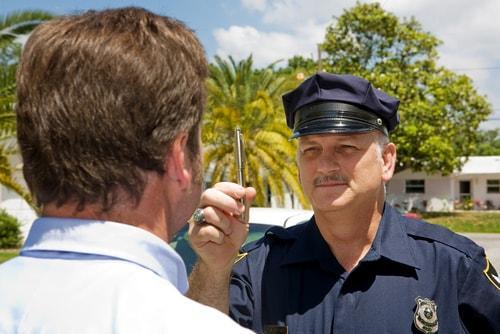Standardized Field Sobriety Tests, Part 1: The Horizontal Gaze Nystagmus Test
 A recent post on this blog talked a little about the use of breathalyzers when drivers are stopped on the suspicion of driving under the influence (DUI). While chemical tests like breathalyzers are commonly used by law enforcement to gather evidence to support a DUI arrest, officers have a number of other tools at their disposal to help them identify drunk drivers. Among these is a battery of tests known as standardized field sobriety tests, or SFSTs, which includes three separate activities during which the officer will look for indicators of intoxication. Over the next several weeks, we will discuss each test in detail.
A recent post on this blog talked a little about the use of breathalyzers when drivers are stopped on the suspicion of driving under the influence (DUI). While chemical tests like breathalyzers are commonly used by law enforcement to gather evidence to support a DUI arrest, officers have a number of other tools at their disposal to help them identify drunk drivers. Among these is a battery of tests known as standardized field sobriety tests, or SFSTs, which includes three separate activities during which the officer will look for indicators of intoxication. Over the next several weeks, we will discuss each test in detail.
The Basics of Field Sobriety Tests
The National Highway Traffic Safety Administration (NHTSA) has officially recognized three separate tests that comprise the battery of SFSTs used by law enforcement officers nationwide. These tests—the horizontal gaze nystagmus, the walk-and-turn, and the one-leg stand—measure specific involuntary responses or reflexes that could be compromised by alcohol or drugs. The tests are not definitive in and of themselves but are part of a larger body of evidence to support an officer’s suspicion that a driver is intoxicated.
Test 1: Horizontal Gaze Nystagmus
The first test is known as the horizontal gaze nystagmus (HGN) test. Nystagmus is another word for the involuntary jerking of the eyeball as a person utilized his or her peripheral vision. An impaired person’s eyes tend to jerk sooner and in a more exaggerated manner than those of a person who has not been drinking.
To conduct the HGN test, an officer will ask the subject to stand still and follow a stimulus—usually a pen or small flashlight—with his or her eyes without moving the head. The officer moves the object from side to side while observing the subject’s eyes. Signs of impairment include that the subject cannot follow the object smoothly, jerking begins before the eyes reach 45 degrees from center, or the jerking is distinct and sustained at the furthest edge of vision. The NHTSA reports that the HGN test properly predicts impairment about 80 percent of the time. The test, however, can also indicate that the subject is taking anti-seizures medicines or other depressants.
Contact a Skilled DUI Lawyer
In upcoming posts, we will take an in-depth look at the walk-and-turn and one-leg stand tests. Meanwhile, if you have been charged with driving under the influence, you need help. Contact an experienced Kane County DUI defense attorney to discuss your case and to explore your available options. Call 847-488-0889 for a free consultation at The The Law Office of Brian J. Mirandola today.
Sources:
https://ntl.bts.gov/DOCS/deskbk.html#AADID
http://duijusticelink.aaa.com/issues/detection/standard-field-sobriety-test-sfst-and-admissibility/







